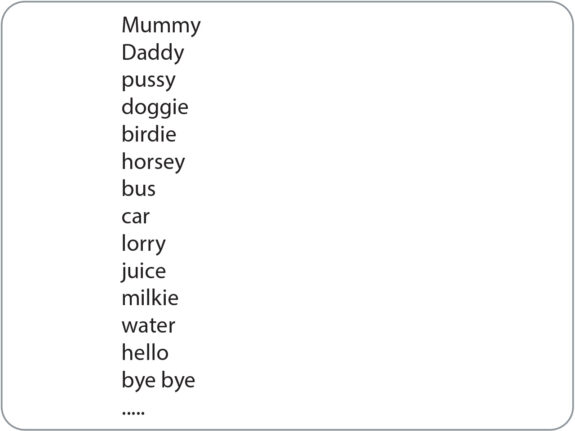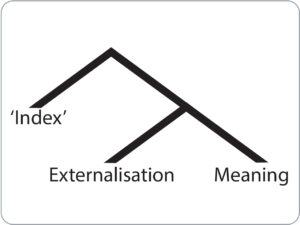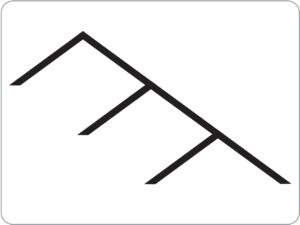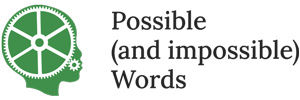
Words (or signs)
Not as simple as they sound or look
If your child is past the age at which most children normally start putting two words together – in the second half of the second year, if your child still has only single words, or if his or her only word is for cat, dog, bird, horse, bus, car, lorry, or to ask for his or her favourite drink, or to say hello or goodbye, it is not obvious what the importance or relevance is of any of the theories here. You might reasonably say to yourself: I don’t care which theory says what about the situation as long as my child just starts putting words together.
The set of accessible words or signs used in a language is known as the ‘lexicon‘. The lexicon varies at least slightly from person to person, sometimes greatly.
It might seem that single words or signs are simple. They aren’t.
The problem of the word, word
The word, word, is problematic. Most words, in the most obvious sense, have an easily identifiable ‘stem’ or ‘root’ in a form like house or compute. Here I am taking one old and one newly-added example. But both can be built on’ by what is known as the ‘morphology’. In English this is uncommonly simple with only one set of sounds used to mark the difference between house and houses, and another set to mark the difference between compute and computed.
BAY, as the first syllable of baby, is not just a possible word, but a real one. But the second syllable, BI, is only a syllable and not a possible word, because apart from the and a which are special cases on independent grounds, all one syllable words in English have either a final consonant or a long vowel.
Catch seems obviously one word. But what about caught? It refers both to the act of catching and to a past time-scale or tense. In a similar way, broke is obviously related to break as the past tense form. Caught and broke both seems to contain two elements, what is known as a ‘root’ and a past tense element – in this case, two ‘morphemes’, as these are known.Morphemes include the ‘S in “He’s a jolly good fellow”, the ‘D in “I’d. be careful”, the ‘LL in “I’ll be there tomorrow”, and the contracted marker of negation in N’T in “Don’t do that.”
A simple thought experiment. A says to B: “Do not do that!” B responds “What was the first word you said?” To which, the only true answer is “Do”. A might follow with: “But don’t!” To which B responds: “What was the last word you said?” Now A has again only one true answer, “Don’t.” Although don’t represents a contraction of do and not, to answer “Not” would be at best perverse. And to try and say N’T would be no answer at all. The process of contraction has formed one word out of two. So how many words does this represent?
What may be a problem for some first language learners is to distinguish between words and morphemes. Words often signal their identity as words by adding syllables, as in doggy and horsey. But this is different from the addition of elements, as in stop as stopped, stops, or stopping. Exactly what can be added to which words is something which has to be learnt. For most children, this is not problematic. There are enough clues in the -S, -ING, -ED additions. But for some children these clues are seemingly not enough.
There is another key distinction between doggy and woof woof or bow wow, cat and miaow, cow and moo, train and choo choo or chuff chuff, where what is often represented to children as the sound is sometimes also taken to be a childish name.Diagnostically, the child may not notice one or more of these things.
In the sound system of English, the final syllable of bottle is part of the word (by a cross-linguistically unusual syllable structure) – with the effect that the odd child says it as BOP without the second syllable and with the lip articulation of the B copied into what becomes the final sound. The normally developing child is highly sensitive to the unstressed second syllable, as one of the special characters of the target language. Not noticing this may be part of a larger problem with the ‘metalinguistics‘ .
More generally, the non-obviousness of what a word is, as opposed to a syllable and a morpheme, is obviously a significant question for the first language learner.
The delight of the first word
Parents are rightly delighted when a child utters his or her first word or uses his or her first sign. This is the first step on the way towards building the lexicon. This is the stage in the acquisition of language, which Roger Brown (1972) called the ‘one word stage’, when single words are all that child’s system can generate. But by the Proposal here this is by doing more than just linking a symbol either a spoken word or a sign – what by the framework here is known as ‘externalisation’ – to a meaning. It also involves defining the position of the symbol in the lexicon, thus making it both classifiable and accessible, effectively ‘indexing’ it in the terminology of computer databases, as shown by the digram below.

The effect of the doubled binary branched structure is that it can be extended indefinitely.

This is exploited when a child of say two and a half says something like “I got one like that” where like that is by a branching of one.
By what I believe is the latest research on this point. Marinus Huybrechts (2017) shows that since a structure with an infinite capacity is more simply stated than one with a finite capacity, there is no logical way for the latter to grow into the former. The doubly branched structure must have been there from the first single words.
Single words are already a significant achievement.

